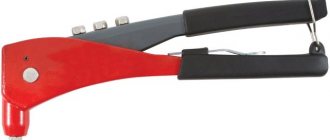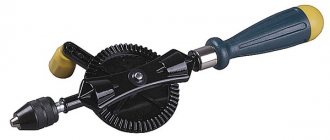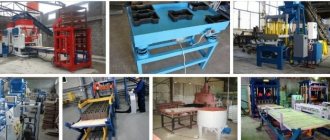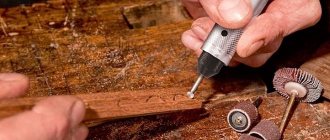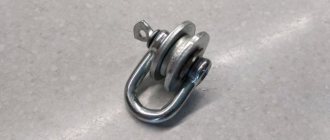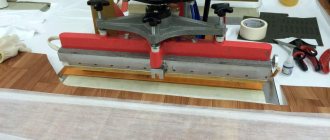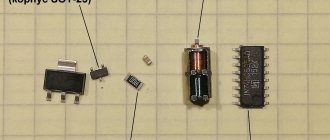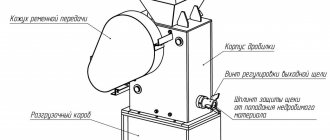Today, not a single large production enterprise can do without the use of pressing equipment, with the help of which a large range of technological operations can be performed. If, as a rule, powerful press installations are used to equip large production enterprises, then the best option for such equipment for home use (as well as for use in small workshops) is a manual press. A tabletop manual press, despite its compact size, also allows you to perform many technological operations with parts made of various materials.
Tabletop hand presses are very popular among home craftsmen
Scope of use of the device
The table press can operate on automatic or manual traction. The popularity of such a device is also explained by its particularly small size. Which is very important given the high rental price for production purposes. This equipment can be called truly durable, as it is made of hardened steel. Such equipment can operate for about 10 years without replacing component mechanisms, as well as without making additional repairs. Its operation does not require consumables, and the maintenance of such a machine can be entrusted to even the most unskilled and inattentive employee in the enterprise.
Using a hand press you can process the following materials:
- Cardboard.
- Skin.
- Foam rubber.
- Plastics and polymers.
- Various types of materials.
- Rubber.
Mechanical presses are actively used in all areas of production activity for pressing plastic containers, paper, various non-ferrous metal waste, aluminum, metal shavings, as well as other waste after production. This type of press is commonly used in printing houses, restaurants and hotels. The press will significantly reduce the costs of waste disposal.
What is a compact tabletop press used for?
Tabletop presses, which are offered today by many mechanical equipment manufacturers, are divided into manual and electrically powered. The high popularity of such equipment is primarily due to its compact size, due to which it does not require a large area to place this device and operate it. The working elements of modern models of tabletop presses are made mainly of high-strength steel, which ensures a long service life of this equipment.
Mechanical manual rack press for home workshop
Tabletop mechanical presses, which are driven by applying physical force, are very popular among owners of small workshops and home craftsmen. This popularity is explained by the simplicity of the design of mechanical hand presses, their unpretentiousness in operation and maintenance, which even a novice home craftsman can cope with. In addition, these desktop devices do not require any consumables to operate.
The most common technological operations that are successfully performed using a manual tabletop press are:
- pressing out and pressing of various bushings and elements of bearing units;
- cutting small parts;
- stamping;
- creating connections using the riveting method.
A manual screw-type press for work related to crimping bindings, books or covers, can also be used in carpentry when gluing workpieces
Tabletop mechanical presses are quite versatile devices that can be used to process products made from various materials, such as:
- metals and their alloys;
- polymers and plastics;
- leather;
- wood;
- cardboard;
- rubber.
Another important advantage that desktop mechanical presses have is that such equipment can operate effectively even at sub-zero temperatures.
Hand press for punching holes in leather
Design and operating features
All processes can be divided according to the shape of the rod into the following:
- Screw.
- Rack and pinion.
The design of desktop equipment that operates using manual traction is quite simple:
- Rack type rod.
- The bed is column-shaped, which is combined with a stand for placing a workpiece or a turntable.
- Specialized shaft.
- A gear train that is driven by a screw or lever.
The principle of operation of such a mechanism is that with the help of manual traction, the general rotational movement of the eccentric is launched. At the same time, it is attached to a piston, which efficiently presses the raw material through a special matrix. With all this, the force of counterpressure should be regulated by the very shape of the matrix , which can be easily replaced with a new one. There are a large number of matrices for different types of raw materials. In addition to this machine, there are special dies for the production of flat components from sheet metal.
When creating a structure, you can use various matrix schemes:
- Spinning.
- Hexagonal replaceable.
- Point replaceable.
Another area of press activity: hydraulic press for cable lugs
Hydraulic press is widely used for crimping cable lugs for high-voltage lines. Using the device, the process of mechanical compression of the connection is performed, which after processing will have greater strength, conduct electricity well, and not overheat, which reduces the likelihood of contact damage and accidents.
Using presses, you can crimp cable lugs.
The manual hydraulic lug press is designed to work with cables with a cross-section of 5-400 mm². When choosing a tool, you should consider some device parameters. The press must have a pressure limiting valve. Such devices are more reliable because they prevent exceeding the permissible pressure.
An important criterion is the type of pressing head, which can be open or closed. The first option provides more convenient and simpler operation for any cable length. To work with a closed-type press, you must first open the stopper, remove the matrix, insert the wire and tip, and close the device. Only after such manipulations is the cable crimped.
When choosing a hydraulic press, it is important to consider the diameter of the working section of the cable. Depending on this, all instrument models can be divided into types. The PG-70 variety is used for wires with a cross section of 4-70 mm². Type PG-120 is intended for cables with a diameter of 10-120 mm², PRG-240 – 16-240 mm². The PGR-300 hydraulic press is capable of working with cables with a cross-section of 16-300 mm². Model PG-1000 is designed for wires with a diameter of 400-1000 mm².
All tool models can work with copper or aluminum wires. Many modern devices are equipped with a high-speed mechanism and rotating heads. Manual hydraulic presses KVT from a domestic manufacturer are very popular. This is due to the affordable cost of the instrument and the high quality of its performance.
Hydraulic presses PG-1000 are used for wires with a diameter of 400-1000 mm².
Note! The KVT hydraulic press kit includes eight replaceable dies for crimping.
Device characteristics
The main characteristic that will mainly determine the application of the press: maximum reinforcement in the area of the rod. In this case, the indicator can vary between 450-5 thousand kilograms. To create an auto repair shop, a pressure of 2 tons is enough, for use in a personal plot - 500 kilograms.
In addition to all this, the very size of the working area and the reach of the rod itself are considered important - it is on them that the dimensions of the manufactured parts will depend. The more powerful the machine, the more it will weigh and the more difficult it will be to lift. So, with the process of increasing the force by one ton, the weight of the device begins to multiply by two. The higher the power rating, the larger the mechanism itself and with the greater number of components it can function.
- Effort (varies from 500 to 5 thousand kilograms).
- The total cross-sectional area of the rod (the larger the area, the larger the product itself can be made).
- The height of the total workpiece (from 10 to 25 centimeters and depends on the range of the rod extension).
The desktop type of product is considered more stable, durable and reliable, and it will also be much easier to work with such equipment. Changing parts in it is quite simple, the parts at this time will come out quite accurate. Accuracy in performing the work will be ensured by the overall rigidity of the structure, as well as the monolithic body.
Screw household presses
The first economic task for which a press is needed is squeezing juice and oil from juicy fruits. The latter, however, is irrelevant in the Russian Federation: olives do not grow here, and oil cannot be squeezed out of seeds by pressure; it is beaten out by impact pressing on oil churns. Juicer presses are often made on the model of production and technological ones from jacks in a wooden frame, because The pressing force required is no more than 1-1.5 tf, see, for example. video:
Video: press for apples, berries and fruits
But the correct press juicer must be a manual screw press with a wooden basket, see fig.:
Manual screw press juicer and its device
The screw gives your hands the ability to sensitively regulate the pressure, and only the press with a wooden basket produces the highest quality virgin juice/oil. If we are talking about grape juice for elite wine, but all parts of the press in contact with it are also made of wood; The best species for this are oak and mulberry aged for at least 3 years.
About winemaking and wine presses
The grape variety and the conditions for its cultivation are not all that is needed to obtain good wine.
For example, many excellent grape varieties grow in the Northern Azov region: the climate is suitable, shell limestone soils are abundant. But during the perestroika struggle for sobriety, an article appeared in Science and Life about the content of fusel oils in homemade alcohol. It was the northern Azov homemade wines that came out on top: 3700 mg/l (!!!). The second place was taken by Sumy potato moonshine, 1900 mg/l; the rest of the “self-propelled guns” were ahead by a wide margin. The holidaymakers who at that time dared to try the local “varyokha” from one glass, excuse me, “got further than they saw.” Winemaking in general is a delicate matter, and squeezing juice into wine is its most important stage. The juice for wine from elite grape varieties is pressed as follows: for Pinot wines, berries of a certain degree of ripeness are manually selected directly from the bunches on the vines. Selected berries are pressed lightly in 3-5 stages so that only pure juice is released without any admixture of slimy pulp, and the seeds and skin do not have time to release tannins. The remainder of the harvest is added to the Pinot pressings and pressed in the usual way; In this way, juice is obtained for wine of the same variety in the Mosto category. Real Mosto is also a very good wine, but Pinot... you understand - hand-picked one berry at a time by experienced highly paid workers and completely manually pressed “with bated breath.” Therefore, the prefix “Pino” to the names of cheap draft wines (by the way, very often very decent ones) is nothing more than a shameless scam. Unfortunately, it is now legalized in most countries with developed winemaking.
Drawings of a manual screw press for squeezing fruit juices of the highest quality are shown in the figure:
Drawings of a screw hand press for extracting premium quality juices
In addition to the above, it has two more significant features. The first is a relatively small diameter steering wheel instead of a gate. It is difficult to turn the gate perfectly evenly; it transfers pressure into the hand weakly and it is easy to crush the load of raw materials. The second is the rectangular thread of the screw-nut running pair. Better, but technologically more difficult - trapezoidal; threads of the same profile are used wherever smooth, precise clamping is required, e.g. in a mechanic's vice.
It is difficult to turn even a rectangular thread, and it is expensive to order, so if you are making such a press, look in scrap metal for unusable water supply or gas main shut-off valves (valves, gate valves). Their running pairs have rectangular threads, which, if the rust is removed, are most often in order - the valves are the first to become unusable.
Note: for more information about making a juicer with a wooden basket, see the video:
Video: juice press
Lever presses
Manual tabletop lever press for installing metal fittings in garments
Lever presses are also quite common in everyday life and households. For example, in sewing for installing eyelets, buttons, fasteners, dress rivets, denim buttons. The structure of a “tailor’s” desktop hand press is shown in Fig. on right. For precise centering of the clamp, its rod slides in the holder, as in a lever press with a sliding stop, see Fig. above. with types of presses. But the kinematic diagram is different: in this case, a pair of pressure levers and shackles is used. In such a press, the clamping force increases quite smoothly along the course of the rod, which is exactly what is needed for high-quality flaring of the sides of metal sewing accessories. At the lower end of the rod there is a blind threaded hole (socket) into which shaped punches for various types of fittings are screwed.
The next pressing operation, which is often required by owners of private farms and small farmers keeping livestock, is hay baling. Moderately compacted hay not only requires less storage space and is less likely to crumble in the process, but is also much less susceptible to pest damage.
For baling hay for storage, mechanized balers are produced and sold, but these are expensive and rather complex units. They justify themselves only in a sufficiently large, profitable economy. The owner of a private plot or a small individual farmer, at least at first, is better off using a scythe, a rake and a manual lever hay baler, the device of which is shown in the following. rice.:
Lever Hand Baler
This is a basket with an opening gate, a simple one, without any kinematic tricks, a lever with a shoulder ratio of 1:6 - 1:10, and a punch (punch) made of a board panel. Hay is loaded into a basket with a closed gate - pressed, loaded - pressed until a bale of the desired size is formed; they take it out by opening the gate.
Manual lever press for forming fuel briquettes
Finally, let’s remember about independent procurement of alternative solid fuel. Fuel pellets, which produce the lowest ash content when burned, are formed in screw thermoforming installations of a rather complex design, see Fig. on right. Their disadvantage from the point of view of the owner is also significant energy consumption, which can negate savings on the purchase of standard fuel for a furnace or boiler.
It is much easier to build a wall-mounted manual lever press for manually pressing fuel briquettes from dry combustible agricultural waste, see next. rice.:
Diagram of a thermoforming installation for producing fuel pellets
For more information about its production, see the video in 2 parts:
Types of hand presses
To use the press in different industries, the following types of manual presses are created:
- Hydraulic. The required force occurs using a hydraulic cylinder rod. The hydraulic cylinder itself contains a certain working fluid, which begins to actively compress under pressure to create connections, compression, and deformation of the shape of objects. It is considered more powerful and of higher quality than a manual mechanism: it is capable of creating tens of tons of force with the slightest effort on the part of the employee.
The main component of the design is a pair of hydraulic cylinders in various sizes, which are filled with technical oil. They operate between themselves using a working fluid. The operating principle of such a device will be very similar to a mechanical one, only in this case a special technical oil is used in place of the lever. The power of the equipment will be directly proportional to the ratio of the diameters of the cylinder and piston.
- Hole punching. A special type of press for stamping holes in sheets of various types of materials, including metal no larger than 4 mm. The total diameter in the punched surfaces will vary from 10 to 40 mm.
- Manual mechanical press. It is used mainly for crimping cables and tubular sleeves. Crimping is the most reliable method of connecting electrical cables; it increases the overall current conductivity, which reduces resistance and prevents overheating in the cable, reduces the possibility of accidents during the production process, as well as burning of individual connections. It is most effective to perform crimping using a mechanical hand press.
This mechanism is presented in the form of a lever, equipped with ratchets or ratchets; they prevent the development of reverse motion and create a fairly strong force so that high-quality adhesion occurs in the wires. The design allows you to easily change the total length of the arms. The pressure that occurs in the equipment can be compared with that provided by a hydraulic analogue , but the second one has a significantly higher cost. To achieve high-quality compression in the wires, you should press the handle several times, and then change the included nozzles.
A mechanical press can work with electrical wires of absolutely any cross-section up to 240 sq. mm. When choosing equipment, it is worth clarifying its operating range. The larger the device, the thicker the cable it can crimp.
- Press jaws. Used for putting lugs and sleeves on special cables and electrical wires. In this case, such a device creates a special press-type profile. Capable of working with a maximum cable cross-section of about 35 square meters. mm. The total weight of the instrument at this time will be three kilograms.
- Tablet press. This is a special device that is designed to create tablets in the laboratory. There are a large number of modifications of tablet devices, including tabletop ones, which perform their work using manual traction. The total productivity in such a device varies from 200 to 1 thousand tablets per hour.
The diameter of the tablets is created by a certain shape in the range from 0.4 to 1 centimeter, the thickness is no more than half a centimeter. The maximum gain will reach 700 kilograms. Laboratory tablet devices can be of the hydraulic type, and also perform work from an electric motor. Such devices will be more powerful , the productivity per hour will be about 6 thousand tablets.
Design and principle of operation of pressing equipment
The design of any stamping equipment consists of the following elements:
- drive motor;
- motion transmission mechanism;
- actuating mechanism.
Main parts of mechanical crank press
Depending on how the drive motor of the press is connected to its actuator, machines with a connection are distinguished:
- mechanical;
- non-mechanical, carried out by liquid, gas or steam.
The actuating mechanism with which equipment for stamping is equipped can be traverses, a slider, rolls, rollers and women.
Crank type presses
The main structural element of these presses is the crank mechanism, which converts the rotational motion it receives from the drive into the reciprocating motion of the slider. The actuator, which is equipped with a stamping press of this type, is connected directly to the slider, capable of developing a force of up to 100 tons. The movement of the slider in such presses occurs at the same frequency.
Crank press assembly die
Crank-type presses can be simple, double or triple acting equipment. Using such machines, you can perform the following technological operations:
- stamping using open and closed type dies;
- sheet metal cutting;
- firmware;
- formation of the finished product by extrusion;
- combined processing.
In cases where more powerful equipment is required to form a finished product from a metal billet, hydraulic type machines are used.
ESSA crank press machine
Hydraulic presses
Using a hydraulic press, you can press both larger and thicker-walled metal parts. Such equipment for sheet metal stamping, die stamping, forging, bending and other technological operations, depending on the specific model, can develop forces from 150 to 2000 tons or even more.
The main structural elements that any hydraulic press is equipped with are two cylinders of different diameters, which are filled with working fluid and communicate with each other. Each of these hydraulic cylinders has a piston that creates pressure of the working fluid or moves under its influence. It is the movement of pistons in hydraulic cylinders that ensures the movement of the actuator of the equipment. The amount of force that such a stamping press can create is determined by the difference in the diameters of its hydraulic cylinders.
Radial forging presses
A radial forging machine is a forming press on which preheated metal blanks are converted into finished products of a cylindrical configuration. The design of presses of this type is:
- an induction furnace in which the workpiece is preheated;
- conveyor for feeding the workpiece into the processing zone;
- gripping mechanisms, with the help of which the metal part being processed, constantly rotating, passes through the forging zone;
- a worm gear connected to an electric motor and responsible for the operation of the gripping mechanisms;
- four shafts with eccentric axle boxes that transmit movement to a connecting rod with a striker, between which a slider is fixed (the shafts themselves, through a V-belt transmission, receive rotation from the drive electric motor);
- copying drums, responsible for the synchronous approach of the strikers and the subsequent movement of the workpiece;
- a spring clutch that provides braking of the part while it is being processed by the strikers.
Radial forging machine is used to produce square or round forgings close to the profile of finished products
Electromagnetic type presses
This is a new type of pressing equipment. The principle of its operation is based on the properties of a core placed in a wire coil through which an electric current passes and moving under the influence of an electromagnetic field. The electromagnet core of such presses acts on the actuator of the machine, directing it to the metal workpiece being processed.
Three-position electromagnetic press for installing fittings
Distinctive characteristics of electromagnetic presses are high productivity of processing and cost-effectiveness of use.
And in conclusion, we suggest watching a short video demonstrating the operation of a jig punch press.
Press selection criteria
- Power indicator. The clamping force in a manual type mechanism will directly depend on the effort on the part of the person. A hydraulic device is considered more complex and powerful, and therefore does not require a person to apply any increased effort; a hydraulic press is considered more powerful and complex in structure, and does not require too much effort; the effect at this time is achieved due to a special design.
- Size indicator. The size of the device is considered a fairly important indicator; it will be especially important for small production points. At the same time, the smaller the device, the fewer parts it will be able to perform work with. A small desktop device can cover the needs of workshops or households. If you are going to do work with large parts, then you should choose a larger unit. In most cases, these perform their work hydraulically.
- Purposes of use. Presses are mainly used only in production or during installation. There are special models for the production of food products, for example, juice. Such drugs are in most cases used in home production.
Homemade press from a jack with your own hands: drawings and diagrams
For some operations, a home craftsman may need a press with significant compression force, but purchasing equipment of this class will be completely unjustified. Today we will tell you how to assemble a reliable press based on a hydraulic car jack in a few hours.
What and how to assemble a frame for the press?
The material for the frame, its structural strength and the method of assembly should be determined by the pressure that the jack is capable of delivering. For accurate calculations, it is important to understand in which direction the loads act during operation.
The base of the press is a rectangular U-shaped frame made of a channel or a paired steel angle. The main acting force is the resistance to compression, expressed in concentrated load. The main force is concentrated in the centers of the horizontal crossbars. The forces that stretch the vertical racks of the press and the phenomena of deformation in compressed parts can be completely neglected.
What can a hydraulic pressing machine be made from?
The most popular device for making a hydraulic press is a jack, the actions of which are based on the operating principle of hydraulics. According to the laws of physics, the liquid in it under pressure does not reduce its volume. Therefore, when impacting the workpiece being processed, no loss of power is observed. In addition, the jack is characterized by high efficiency, thanks to which you can count on significant compression force.
To make a homemade device, you can use a diagram of a hydraulic press from a jack, which can be found on the Internet. At the first stage, a structural frame is created from a steel profiled pipe, metal corners and a plate. A jack is installed between the thrust plate and the platform, and it is necessary that when the rod is retracted, the tip of the rod is inside the latch. The base of the tool is attached to the movable stop using bolts.
To make a hydraulic press with your own hands, use a jack.
To crimp metal workpieces, the product is placed on a platform, the jack is raised when its lever is pressed. In this case, the pressing process occurs. It is important to know how to lower a hydraulic jack, which must be done after finishing the job. For this purpose, the tool is equipped with a bypass valve. It has a round head with protruding shoulders. It must be loosened, causing the device to lower.
The jack also has a shut-off valve that, when closed, pumps oil into the piston. Normal operation of the device indicates a sufficient amount of fluid in the system. If the tool starts to work slowly or stops completely, this means that there is little working fluid in it. You need to know how to fill a hydraulic jack with oil. To do this, there is a special filler plug on the device body, which must be unscrewed. Next, the tank is filled to the required volume. At the end of the procedure, the jack is pumped.
A manual hydraulic press is a multifunctional equipment that is widely used in car repair shops. This is an indispensable assistant for the home workshop. When choosing a device, it is important to determine the scope of its use. For domestic purposes, a device designed for a force of up to 20 tons is sufficient, but for a large service station a hydraulic press of 50 tons is needed. You can save money by making your own press from a jack.
Features of metal press systems
Metal press systems consist of pipes, innovative fittings and special press tools for their installation. It is universal, as it can be used in systems for both heating and water supply. There are no O-rings or cuffs in the system; Safety circuits are provided for quick and reliable crimping of connections. They allow you to detect unpressed fittings during the first leak test. The connections are one hundred percent reliable and durable - manufacturers guarantee a service life of at least 50 years.
Due to the absence of O-rings and internal roundings of large radius, the diameter of the flow section does not narrow, and the water pressure remains strong even at joints and turns.
And since when installing the system, quite a lot of additional and time-consuming operations are eliminated (calibration of pipes and additional adjustment of diameters, installation of O-rings in fittings, etc.), installation time is reduced by almost a third.
Installation rules: secrets of specialists
The assembly of metal-plastic pipes using press connections is not technologically difficult. Before starting work, clear the area of debris and dust.
To work you will need tools:
- Pipe cutter For metal-plastic material this is the best option. When cutting such a pipe with a hacksaw, you will not encounter any particular difficulties, but the cut will be unsuitable for installation. you will need to additionally chamfer both sides of the cut, align the cut geometry to the correct circle, and remove all burrs. When using a pipe cutter, you will get a cut of the desired quality without additional processing.
- If you used a hacksaw or other improvised tools to cut the pipe, then you will need a gauge. This tool will straighten the circle and remove the chamfer.
- Press tongs (manual) or electric press machine. For one-time work on small sizes, you can get by with hand tools.
The connection to the crimp sleeve is made according to the following scheme:
- a press sleeve is placed on the outer part of the pipe;
- insert the fitting inside, pushing it all the way;
- crimp the sleeve with pliers.
When using a sliding sleeve, the procedure is as follows:
- a press sleeve is placed on the outer part of the pipe, moving it away from the edge;
- use an expander to increase the diameter of the pipe, insert the fitting all the way (without expansion, the pipe will not fit onto the fitting of the part with a sliding sleeve);
- Using special pliers, pull the press sleeve onto the pipe with the fitting and crimp it.
- The pipe should be cut for each section sequentially during the work, this will allow you to avoid getting confused in the finished sections;
- The fitting is crimped once; repeating this operation will lead to damage to the part;
- The chamfer can be replaced with sandpaper and a sharp knife;
In the summer, work can begin immediately, regardless of where the purchased materials were stored. In winter, you will have to wait several hours for the material to warm up to room temperature. The best solution is to bring in the pipes, fittings, and tools in the evening and leave them to warm up and dry the condensate overnight.
Types of tools for installing metal-plastic pipes
The following tools are used to connect metal-plastic pipes:
- Pipe cutter or scissors for cutting metal-plastic.
- Angle grinder (grinder).
- Pipe bender
- Construction hairdryer.
- Hand press or press tongs.
The grinder and hair dryer are driven by an electric motor. Household pipe benders for metal-plastic pipes are usually manually driven. The manual crimping press has several varieties with different types of drives.
Mechanical
Manual or mechanical mini pliers are used for crimping water pipes with a diameter of up to 20 mm. These are used for internal distribution of hot and cold water. These tools do not have an electric drive or hydraulic boosters; human muscle power is used to operate them.
Manual drive
Manual pipe benders and homemade Volnov machines have a more complex design than simple tools. The force required for bending is quite significant, and levers are used to operate such structures.
To crimp metal-plastic heating pipes (25 mm, sometimes 32 mm), use a standard manual press for crimping press fittings. To enhance a person’s muscular strength, a gear drive is used, and it also helps to correctly adjust the crimping force.
Hydraulic
For crimping larger diameter pipelines (up to 32 mm), hydraulic models of pliers are produced. A reinforcing hydraulic cylinder is built into one of the pliers handles. When the handles are compressed, the pressure in the hydraulic cylinder increases and the force is transferred to the crimping head of the pliers. Such pliers are quite expensive (from 10,000 rubles), they require qualified maintenance.
Electrohydraulic option
All previous models are used for the installation of metal-plastic engineering systems in small volumes. In industrial construction or if you constantly install plumbing systems, it makes sense to purchase a powerful electro-hydraulic pressing tool. Such equipment is used for installation of pipelines with a diameter of up to 108 mm.
Electro-hydraulic pressing tools have high productivity and the highest quality and tightest compression. The devices are equipped with nozzles for crimping pipes of different diameters. Electric pliers for household running diameters up to 50 mm can be powered by batteries.
